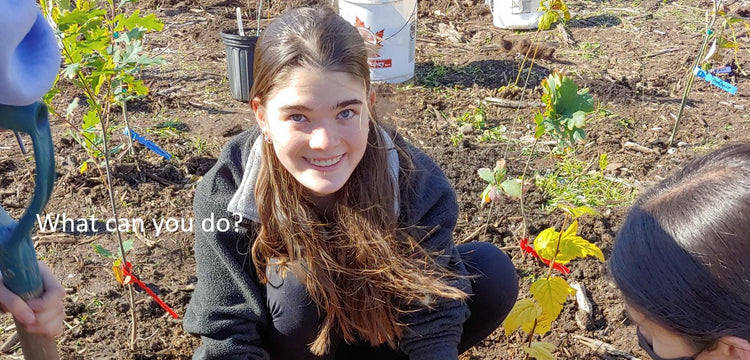"I've never heard anyone talk about Nature like this before" said one of the high school delegates to Joyce and I after we finished our keynote at the third annual Youth Climate Action Summit organized by the Frontenac Arch Biosphere. On November 22, 2022 we joined students from all over Southern Ontario at the Brockville Aquatarium, some in person, some online, to give our talk titled, It's All About Relationships: Little Forests and Local Action.
The Youth Climate Action Summit is a chance for teams of 5 students aged 14-19 to come together, learn more about climate change and its challenges and then come up with a plan to take action at their school and community. You can find out more about it here, https://frontenacarchbiosphere.ca/event/youth-climate-action/ . In the past two years, I have taken the Eco Club from Kingston Secondary School (KSS) to this summit. Our action plan the first year was to support Little Forests Kingston in the planting of the first Little Forests in Kingston. Our hope at the time was to use the money to plant our own Little Forest at KSS. That hope is still alive as we wait for the land to become available for that purpose. Our group that year won one of four $500 grants for our plan and presentation and with that money we bought all the American Hazelnuts that were planted at Hwy 15 and the Lakeside Community Garden Little Forests.
Last year, our KSS group's proposal concentrated on public transportation and how to get more of KSS's students on it. Part of that was imagining beautiful bus stops with green roofs surrounded by tree and shrub plantings, especially edible ones. We also imagined the bus stops as places where information about local climate and biodiversity initiatives could be disseminated to encourage those using the bus to get involved.
What I learned at these Youth Climate Action Summits and as a high school teacher is that our youth are keen to get to work on the challenge of climate change and biodiversity loss. They are full of ideas and enthusiasm. They are looking for ways to contribute and to work together for a better future. We hoped in our talk to bring them to a vision of the future that was full of hope, community and relationship with transformed cities, cities enveloped by forests.
We began our talk by inviting everyone to imagine a tree, a forest and then its roots. We asked them to share what they experienced and how it made them feel. Here is the resulting word cloud.

The heart of our message was that climate change is a symptom of a much larger problem, our broken relationship with Nature. Building that relationship is something each and every one of us can do simply by stepping out the door, approaching the nearest plant and saying hello, who are you, why are you here, what are your gifts and responsibilities, how can I help you?, as Robin Wall Kimmerer has encouraged us to do.
Later in our talk after we had introduced the idea of a City in a Forest by 2030, we asked them to imagine their cities, their workplaces and their homes in such a city. Here is the resulting word cloud.

We ended our talk with ways they could take action, first by getting to know their plant relatives, then by inviting them back to the places they live and learn and then by reaching out to their larger community and finding the people already at work planting and supporting forests or by helping their councilor and mayor understand why they need to go beyond tree planting to forest planting. Our last message was to vote as soon as they can and to raise their voices wherever they live as they build relationships with each other and with our more than human kin. It was such a privilege to spend time with these young people. Miigwech Nai:wen to the Frontenac Arch Biosphere for the invite.

